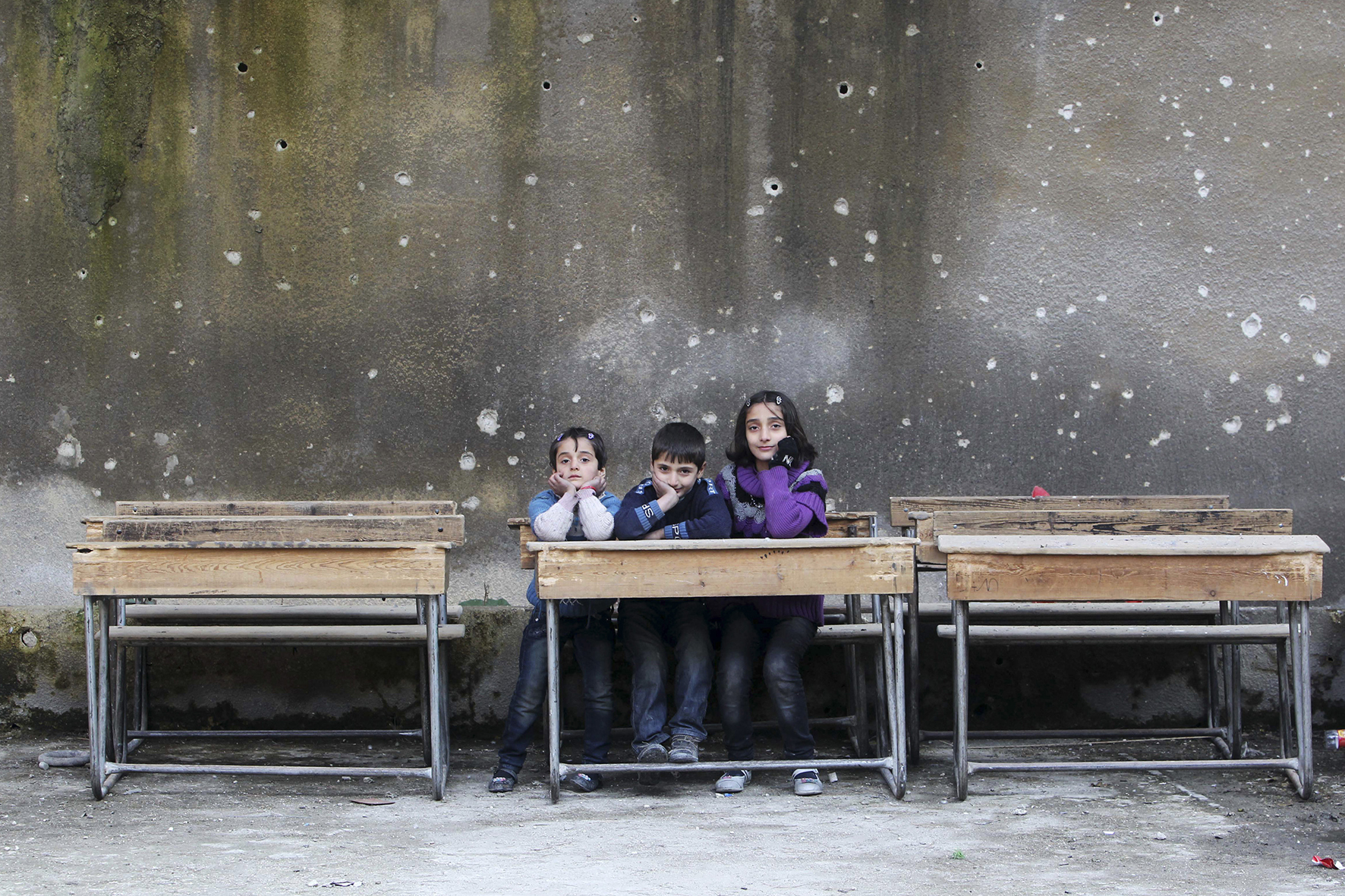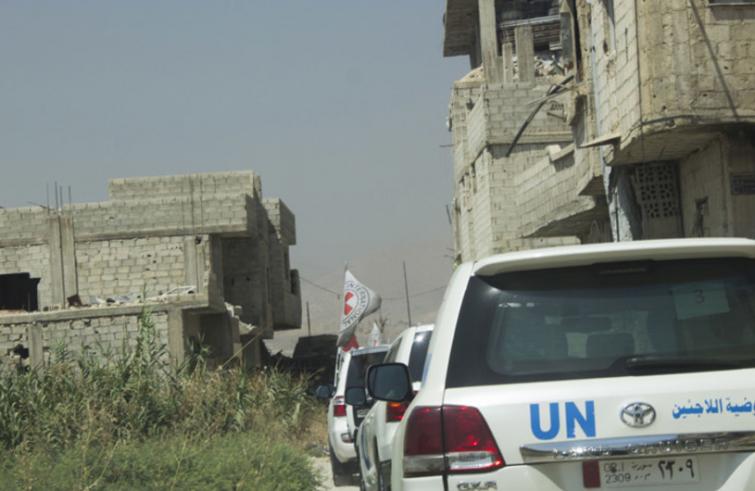Armed conflicts
On March 13 Panos Moumtzis, UN Humanitarian coordinator for the Syria Crisis, Kate Gilmore, UN High Commissioner for Human Rights, alongside with various humanitarian and relief organizations in support of children and civilians, including, inter alia, the Commission for International Affairs and the World Council of Churches attended a high-level meeting at the UN seat in Geneva to discuss the findings of a Report on the Syrian crisis. The UN estimates that approximately 27 thousand people have been killed since the outbreak of the war, 1.5 million no longer go to school, while of the more than five million across the country who are in acute need, 663,000 are under the age of five

(from New York) Hala is eight years old. A incendiary bomb blasted out her home in Aleppo. The burn affected 70% of her body and she was left disfigured. Hozaifa, a 17-year old youth, was coming home from school in Idlib when a bomb blew off his limbs and left him on a wheelchair. Over the past year the war in Syria bears the name of at least 910 children killed and 361 injured.
Twenty-seven thousand people have been killed since the outbreak of the war, 1.5 million no longer go to school while of the more than five million across the country who are in acute need, 663,000 are under the age of five. Children pay the heaviest price of a conflict that has been raging in the Country for eight years, that turned its youths in a lost generation, plagued by the bombings amidst heinous violence, overcome by constant fear without goods or services, unable to access education, healthcare assistance, with no moment of leisure.
The figures of the violence and its victims are contained in a Report discussed on March 13 at the UN seat in Geneva during a high-level panel meeting attended by UN Regional Humanitarian Coordinator for the Syria Crisis Panos Moumtzis, UN Deputy High Commissioner for Human Rights Kate Gilmore alongside with various relief agencies and NGOs providing assistance to the children and civilians, such as the Commission for International Affairs and the World Council of Churches.
 Spotlight on the situation of Syria’s east Ghouta, an enclave near Damascus occupied by 350 thousand civilians besieged by the Syrian government and its allies. They are suffering starvation and they’re on their last legs after humanitarian relief convoys were denied access. Sick and injured children need to leave the enclave but they remain prisoners of escalating attacks against schools, hospitals and civilian infrastructures that testify to the daily violations of international law and human rights. Despite the horrifying situation the children of Ghouta continue going to underground schools set up to escape the bombings, they have continued breathing oxygen – or what remained of it – after repeated chemical attacks, they continued to greet people despite their amputated limbs and dream coloured kites decorating the skies instead of warplanes.
Spotlight on the situation of Syria’s east Ghouta, an enclave near Damascus occupied by 350 thousand civilians besieged by the Syrian government and its allies. They are suffering starvation and they’re on their last legs after humanitarian relief convoys were denied access. Sick and injured children need to leave the enclave but they remain prisoners of escalating attacks against schools, hospitals and civilian infrastructures that testify to the daily violations of international law and human rights. Despite the horrifying situation the children of Ghouta continue going to underground schools set up to escape the bombings, they have continued breathing oxygen – or what remained of it – after repeated chemical attacks, they continued to greet people despite their amputated limbs and dream coloured kites decorating the skies instead of warplanes.
There were 8.35 million children in Syria before the war. Today nearly two thirds require humanitarian assistance with more than one million living in hard-to-reach areas, and 170,000 in besieged areas. Half of the 3 million internally displaced persons are minors.
 “In 2017, 25% of boys and girls under the age of 15 were recruited and used in the fighting by all sides– of course considered a war crime and prohibited under international humanitarian law,” said Panos Moumtzis, addressing the most painful and cruel scourge of the war. “Nine out of 10 recruited children served in a combat role: in uniform, armed and with military training. Growing up in conflict, they may have little choice or alternative; they may also have no way out, as killing or detention by the other side may await them.” Children aged 13 to 18 were imprisoned and treated as adults. Many boys were sexually violated by ISIS militants and the girls were forced to marry some of the most vicious mercenaries among them. Hundreds of minors have been forced into false testimony, others have been accused of apostasy and spies in favour of the government and international intelligence groups.
“In 2017, 25% of boys and girls under the age of 15 were recruited and used in the fighting by all sides– of course considered a war crime and prohibited under international humanitarian law,” said Panos Moumtzis, addressing the most painful and cruel scourge of the war. “Nine out of 10 recruited children served in a combat role: in uniform, armed and with military training. Growing up in conflict, they may have little choice or alternative; they may also have no way out, as killing or detention by the other side may await them.” Children aged 13 to 18 were imprisoned and treated as adults. Many boys were sexually violated by ISIS militants and the girls were forced to marry some of the most vicious mercenaries among them. Hundreds of minors have been forced into false testimony, others have been accused of apostasy and spies in favour of the government and international intelligence groups.
Seven years of violence have caused mental disabilities, especially in children, who witnessed the murder of their family members with reports of suicide attempts, prolonged insomnia and depression.
 The truce demanded by the UN Security Council past February failed to stop the violence: 200 children were killed since its implementation and only one humanitarian convoy was authorised to enter the warfront. “These figures and this escalating wave of violence should prompt us to strongly rethink the overall approach and put human rights before the procedures in Treaties and Resolutions”, participants reiterated during the UN panel debate.
Kate Gilmore reported that “widespread human rights violations and violations of international humanitarian law affecting or targeting children are being committed” by Syrian authorities and by the armed militia present in the region. However, she warned: “Those responsible for this violence – within Syria and beyond – should know that they are being identified; that dossiers are being built up for their prosecution; and that, with evidence in hand, and before duly convened tribunals, they will be held legally accountable for those crimes that with malice, indifference and great cruelty they continue to wage with scant regard for Syria’s children.”
The truce demanded by the UN Security Council past February failed to stop the violence: 200 children were killed since its implementation and only one humanitarian convoy was authorised to enter the warfront. “These figures and this escalating wave of violence should prompt us to strongly rethink the overall approach and put human rights before the procedures in Treaties and Resolutions”, participants reiterated during the UN panel debate.
Kate Gilmore reported that “widespread human rights violations and violations of international humanitarian law affecting or targeting children are being committed” by Syrian authorities and by the armed militia present in the region. However, she warned: “Those responsible for this violence – within Syria and beyond – should know that they are being identified; that dossiers are being built up for their prosecution; and that, with evidence in hand, and before duly convened tribunals, they will be held legally accountable for those crimes that with malice, indifference and great cruelty they continue to wage with scant regard for Syria’s children.”